Developer Guide
Acknowledgements
Setting up, getting started
Refer to the guide Setting up and getting started.
Design
.puml files used to create diagrams in this document docs/diagrams folder. Refer to the
PlantUML Tutorial at se-edu/guides to learn how to create
and edit diagrams.
Architecture

The Architecture Diagram given above explains the high-level design of the App.
Given below is a quick overview of main components and how they interact with each other.
Main components of the architecture
Main (consisting of classes Main and MainApp) is in charge of the app launch and shut down.
- At app launch, it initializes the other components in the correct sequence, and connects them up with each other.
- At shut down, it shuts down the other components and invokes cleanup methods where necessary.
The bulk of the app’s work is done by the following four components:
-
UI: The UI of the App. -
Logic: The command executor. -
Model: Holds the data of the App in memory. -
Storage: Reads data from, and writes data to, the hard disk.
Commons represents a collection of classes used by multiple other components.
How the architecture components interact with each other
The Sequence Diagram below shows how the components interact with each other for the scenario where the user issues the command delstaff 1. Note that both the address book and transaction book are saved.

Each of the four main components (also shown in the diagram above),
- defines its API in an
interfacewith the same name as the Component. - implements its functionality using a concrete
{Component Name}Managerclass (which follows the corresponding APIinterfacementioned in the previous point).
For example, the Logic component defines its API in the Logic.java interface and implements its functionality using the LogicManager.java class which follows the Logic interface. Other components interact with a given component through its interface rather than the concrete class (reason: to prevent outside component’s being coupled to the implementation of a component), as illustrated in the (partial) class diagram below.

The sections below give more details of each component.
UI component
The API of this component is specified in Ui.java

The UI consists of a MainWindow that is made up of parts e.g.CommandBox, ResultDisplay, CardListPanel etc. All these, including the MainWindow, inherit from the abstract UiPart class which captures the commonalities between classes that represent parts of the visible GUI.
The UI component uses the JavaFx UI framework. The layout of these UI parts are defined in matching .fxml files that are in the src/main/resources/view folder. For example, the layout of the MainWindow is specified in MainWindow.fxml
The UI component,
- executes user commands using the
Logiccomponent. - listens for changes to
Modeldata so that the UI can be updated with the modified data. - keeps a reference to the
Logiccomponent, because theUIrelies on theLogicto execute commands. - depends on some classes in the
Modelcomponent, as it displaysPersonobject residing in theModel.
Logic component
API : Logic.java
Here’s a (partial) class diagram of the Logic component:

The sequence diagram below illustrates the interactions within the Logic component, taking execute("delstaff 1") API call as an example.
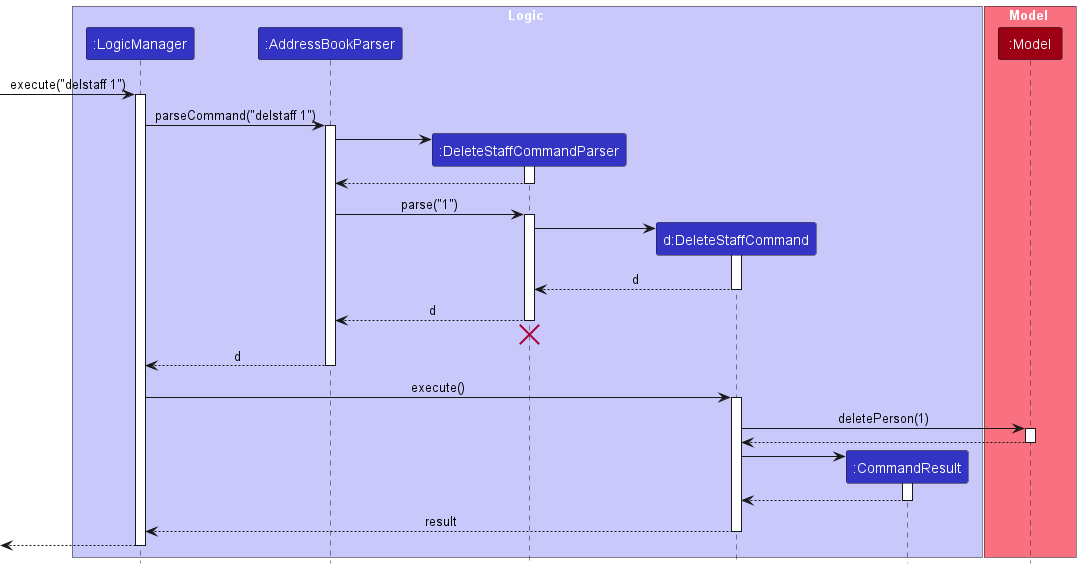
DeleteStaffCommandParser should end at the destroy marker (X) but due to a limitation of PlantUML, the lifeline reaches the end of diagram.
How the Logic component works:
- When
Logicis called upon to execute a command, it is passed to anAddressBookParserobject which in turn creates a parser that matches the command (e.g.,DeleteStaffCommandParser) and uses it to parse the command. - This results in a
Commandobject (more precisely, an object of one of its subclasses e.g.,DeleteStaffCommand) which is executed by theLogicManager. - The command can communicate with the
Modelwhen it is executed (e.g. to delete a person). - The result of the command execution is encapsulated as a
CommandResultobject which is returned back fromLogic.
Here are the other classes in Logic (omitted from the class diagram above) that are used for parsing a user command:

How the parsing works:
- When called upon to parse a user command, the
AddressBookParserclass creates anXYZCommandParser(XYZis a placeholder for the specific command name e.g.,AddStaffCommandParser) which uses the other classes shown above to parse the user command and create aXYZCommandobject (e.g.,AddStaffCommand) which theAddressBookParserreturns back as aCommandobject. - All
XYZCommandParserclasses (e.g.,AddStaffCommandParser,DeleteStaffCommandParser, …) inherit from theParserinterface so that they can be treated similarly where possible e.g, during testing.
Model component
API : Model.java

AddressBook
- Stores the address book data i.e., all
Personobjects (which are contained in aUniqueEntryMapobject). - Stores the currently ‘selected’
Personobjects (e.g., results of a search query) as a separate filtered list which is exposed to outsiders as an unmodifiableObservableList<Person>that can be ‘observed’ e.g. the UI can be bound to this list so that the UI automatically updates when the data in the list change. - Stores a
UserPrefobject that represents the user’s preferences. This is exposed to the outside as aReadOnlyUserPrefobjects. - Does not depend on any of the other three components (as the
Modelrepresents data entities of the domain, they should make sense on their own without depending on other components)
Person class diagram
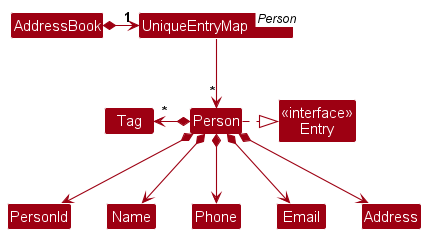
TransactionBook
- Introduces a new component, the
TransactionBook, responsible for managing financial transactions. - Utilizes a
UniqueEntryMapto associate transactions with their uniquetransactionId. - Similar to the
AddressBook, maintains anObservableList<Transaction>that can be observed by external entities, facilitating automatic updates in the UI. - In addition to a filtered list like in
AddressBook, theTransactionBookalso maintains a sorted list of transactions, which is used to sort filtered transactions by relevant attributes.
Transaction class diagram
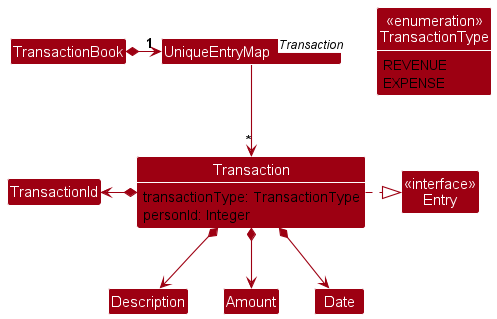
Storage component
API : Storage.java

The Storage component,
- can save address book data and user preference data in JSON format, and saves transaction book data in CSV format. It can also read them back into corresponding objects.
- inherits from
AddressBookStorage,TransactionBookStorageandUserPrefStorage, which means it can be treated as either one (if only the functionality of only one is needed). - depends on some classes in the
Modelcomponent (because theStoragecomponent’s job is to save/retrieve objects that belong to theModel)
Common classes
Classes used by multiple components are in the transact.commons package.
Implementation
This section describes some noteworthy details on how certain features are implemented.
[Proposed] Undo/redo feature
Proposed Implementation
The proposed undo/redo mechanism is facilitated by VersionedAddressBook. It extends AddressBook with an undo/redo
history, stored internally as an addressBookStateList and currentStatePointer. Additionally, it implements the
following operations:
-
VersionedAddressBook#commit()— Saves the current address book state in its history. -
VersionedAddressBook#undo()— Restores the previous address book state from its history. -
VersionedAddressBook#redo()— Restores a previously undone address book state from its history.
These operations are exposed in the Model interface as Model#commitAddressBook(), Model#undoAddressBook()
and Model#redoAddressBook() respectively.
Given below is an example usage scenario and how the undo/redo mechanism behaves at each step.
Step 1. The user launches the application for the first time. The VersionedAddressBook will be initialized with the
initial address book state, and the currentStatePointer pointing to that single address book state.
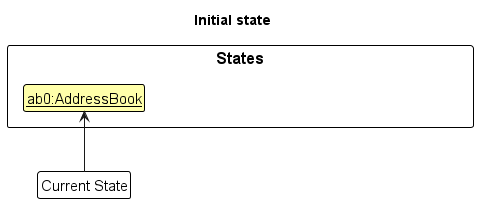
Step 2. The user executes delete 5 command to delete the 5th person in the address book. The delete command
calls Model#commitAddressBook(), causing the modified state of the address book after the delete 5 command executes
to be saved in the addressBookStateList, and the currentStatePointer is shifted to the newly inserted address book
state.
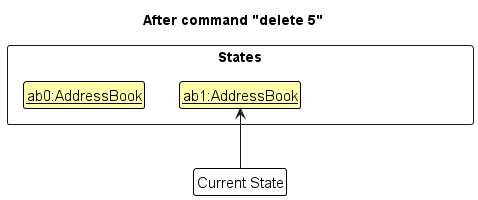
Step 3. The user executes add n/David … to add a new person. The add command also
calls Model#commitAddressBook(), causing another modified address book state to be saved into
the addressBookStateList.
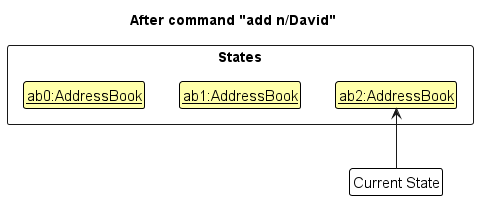
Model#commitAddressBook(), so the address book state will not be saved into the addressBookStateList.
Step 4. The user now decides that adding the person was a mistake, and decides to undo that action by executing
the undo command. The undo command will call Model#undoAddressBook(), which will shift the currentStatePointer
once to the left, pointing it to the previous address book state, and restores the address book to that state.

currentStatePointer is at index 0, pointing to the initial AddressBook state, then there are no previous AddressBook states to restore. The undo command uses Model#canUndoAddressBook() to check if this is the case. If so, it will return an error to the user rather
than attempting to perform the undo.
The following sequence diagram shows how the undo operation works:
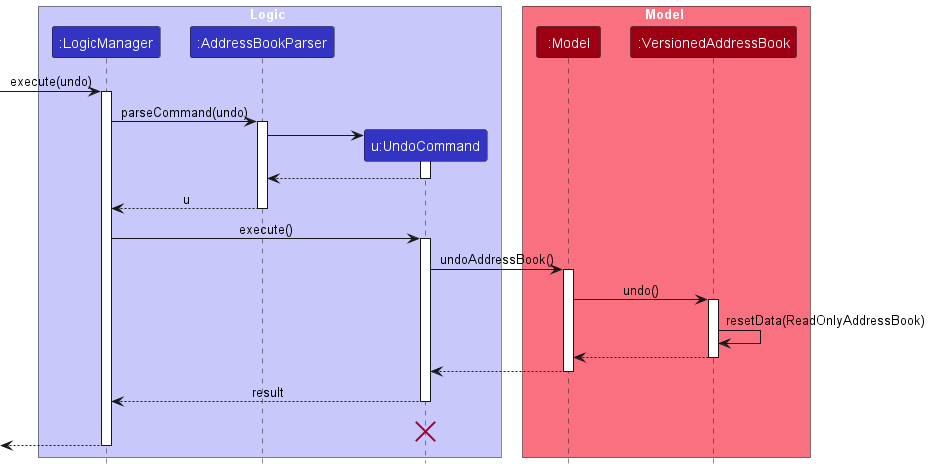
UndoCommand should end at the destroy marker (X) but due to a limitation of PlantUML, the lifeline reaches the end of diagram.
The redo command does the opposite — it calls Model#redoAddressBook(), which shifts the currentStatePointer once
to the right, pointing to the previously undone state, and restores the address book to that state.
currentStatePointer is at index addressBookStateList.size() - 1, pointing to the latest address book state, then there are no undone AddressBook states to restore. The redo command uses Model#canRedoAddressBook() to check if this is the case. If so, it will return an error to the user rather than attempting to perform the redo.
Step 5. The user then decides to execute the command list. Commands that do not modify the address book, such
as list, will usually not call Model#commitAddressBook(), Model#undoAddressBook() or Model#redoAddressBook().
Thus, the addressBookStateList remains unchanged.
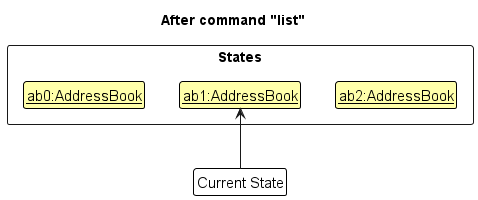
Step 6. The user executes clear, which calls Model#commitAddressBook(). Since the currentStatePointer is not
pointing at the end of the addressBookStateList, all address book states after the currentStatePointer will be
purged. Reason: It no longer makes sense to redo the add n/David … command. This is the behavior that most modern
desktop applications follow.
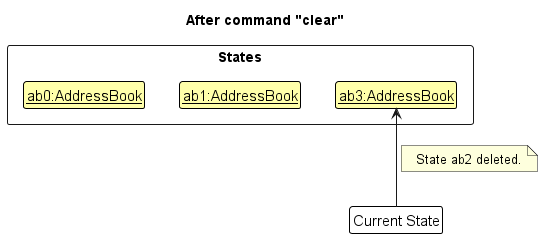
The following activity diagram summarizes what happens when a user executes a new command:
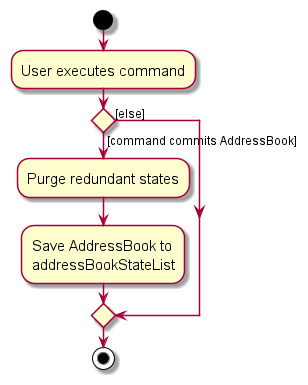
Design considerations:
Aspect: How undo & redo executes:
-
Alternative 1 (current choice): Saves the entire address book.
- Pros: Easy to implement.
- Cons: May have performance issues in terms of memory usage.
-
Alternative 2: Individual command knows how to undo/redo by itself.
- Pros: Will use less memory (e.g. for
delete, just save the person being deleted). - Cons: We must ensure that the implementation of each individual command are correct.
- Pros: Will use less memory (e.g. for
{more aspects and alternatives to be added}
[Proposed] Data import
The data import feature will enable users to seamlessly bring in external data into the application, supporting formats such as CSV and JSON. The process involves several key steps:
-
User Command or Interface:
- Define a user command or interface to initiate the data import process.
- Users can invoke the import feature through a specific command, such as “import,” followed by the path to the external file.
-
Parsing External Data:
- Implement parsers for the supported data formats (e.g., CSV, JSON).
- These parsers, such as
CsvAdaptedTransactionStorageandJsonAddressBookStorage, are responsible for interpreting the external data. - Extract relevant information from the external file and convert it into the internal format used by the application.
-
Updating Internal Model:
- Update the internal model components, such as
AddressBookandTransactionBook, with the imported data. - Utilize methods like
readTransactionBook(Path path)inCsvAdaptedTransactionStorage.javaandreadAddressBook(Path path)inJsonAddressBookStorage(Path filePath)for transaction book and address book importation, respectively. - Ensure proper validation of the imported data and handle potential conflicts with existing data appropriately.
- Update the internal model components, such as
-
Feedback to User:
- Implement a robust feedback mechanism to inform users about the success or failure of the import operation.
- Assign different types of exceptions to various format errors or inconsistencies with the required format.
- Provide detailed feedback on any issues or conflicts encountered during the import process.
- Consider generating a
CommandResultthat reflects the outcome of the import operation, indicating success or specifying the encountered errors.
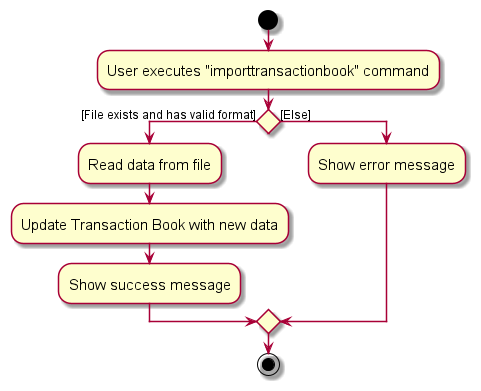
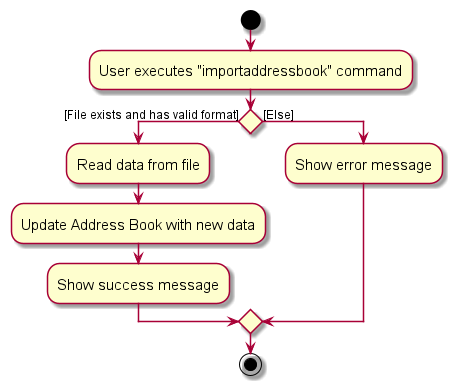
The “import transactionbook” and “import addressbook” features shall be designed as a subclass of the Command class,
responsible for coordinating the entire import process. When execute() , the command class invokes the above-mentioned
methods for reading and updating the internal model. The CommandResult generated by the command depends on the success
or failure of the import operation, providing valuable feedback to the user.
Documentation, logging, testing, configuration, dev-ops
Appendix: Requirements
Target User Profile
Tran$act is specifically tailored for accountants and finance professionals in small businesses who have the following characteristics:
-
Need to manage a significant number of transactions: Tran$act is designed to handle a high volume of financial transactions efficiently.
-
Fast typists: Users are expected to be proficient in typing, as the application primarily relies on keyboard inputs for data entry and interaction.
-
Prefer CLI interactions: Our users prefer command-line interactions over graphical user interfaces, as it allows for quicker data entry and navigation.
-
Reasonably comfortable with CLI apps: Users should have a basic understanding of using command-line applications.
-
Required to produce financial reports: Tran$act can automatically produce financial reports given the transactions that have been entered.
-
Required to sort or filter transactions: Tran$act can automatically filter and sort transactions based on the user’s needs.
-
Value Proposition: Quickly add company revenue and expenses via the CLI. Easily keep track of company profits and visualize them. Cheap solution for small businesses with limited capital.
User Stories
| Priority | As a … | I want to … | So that I can… |
|---|---|---|---|
* * * |
new user | see usage instructions | refer to instructions when I forget how to use the App |
* * * |
user | add a new person | |
* * * |
user | delete a person | remove entries that I no longer need |
* * * |
user | find a person by name | locate details of persons without having to go through the entire list |
* * |
user | hide private contact details | minimize chance of someone else seeing them by accident |
* |
user with many persons in the address book | sort persons by name | locate a person easily |
| Transaction Recording | |||
* * * |
user | add a new transaction | |
* * * |
user | remove a transaction | |
* * * |
user | view all transactions | |
* * |
user | edit transactions through the software | |
* * |
user | edit transactions without opening the software | |
| Financial Reporting | |||
* |
user who needs to analyze transactions | have a variety of financial reports | |
* |
user who needs to share data with others | generate reports downloadable in common formats (PDF, CSV) | |
* |
user | restore from a backup | undo large changes |
| Data Security and Backup | |||
* |
user who needs to keep sensitive data confidential | encrypt the data | ensure the security and privacy of financial data |
* |
user who does not have reliable hardware | have automated backups | prevent unnecessary data loss |
* |
user | restore from a backup | undo large changes |
Transaction Recording
-
Adding a Transaction
- As an accountant, I want to add a new financial transaction quickly.
- I should be able to specify the amount, type (revenue or expense), date, and optionally, the associated person for the transaction.
-
Removing a Transaction
- As an accountant, I want to delete a transaction when necessary.
- I should be able to remove a transaction from the records to correct mistakes or manage data.
-
Viewing All Transactions
- As an accountant, I want to see a list of all recorded transactions for reference.
- This list will provide an overview of all financial activities in one place.
-
Editing a Transaction
- As an accountant, I need the ability to edit transaction details.
- I should be able to make corrections or updates to transaction records as needed.
-
Restoring Deleted Transactions
- As an accountant, I want a safety net for accidental deletions.
- I should be able to retrieve transactions I have mistakenly deleted from a “bin” or archive.
-
Fast Data Entry
- As a fast typist, I want shortcuts and efficient data entry methods.
- This will enable me to record transactions, including revenue and expenses, quickly via the CLI.
-
Sorting Transactions
- As an accountant, I want to be able to sort through my transactions.
- This will enable to me view my transactions in the order I want them to be viewed in.
-
Filtering Transactions
- As an accountant, I want to be able to filter my transactions.
- This will enable to me see the transactions I want to see.
-
Exporting Transactions
- As an accountant, I want to be able to export my transactions into csv format.
- This will allow me to share transaction data with stakeholders, or use the data to do further analysis in Excel.
Dashboard Overview
-
Dashboard Display
- As an accountant, I want to see a clear and concise dashboard upon opening the app.
- The dashboard should display total revenue, total expenses, net profit for the selected period (usually monthly), and a breakdown of expenses by sector to improve cost efficiency.
Financial Reporting
-
Access to Financial Reports
- As an accountant who analyzes transactions, I need access to various financial reports.
- I should be able to generate income statements, balance sheets, and cash flow statements.
-
Customizable Reports
- As an accountant who shares data with stakeholders, I want to generate customizable reports.
- I should be able to create reports in common formats (PDF, CSV, Excel) to share with others.
Data Security and Backup
-
Data Security
- As a user who values data privacy, I expect the app to secure financial data.
- The app should implement security measures, potentially including encryption, to protect sensitive information.
-
Automated Backups
- As a user concerned about data loss, I want the option for automated backups.
- The app should allow me to set up automated backups to prevent data loss due to hardware issues.
-
Undo and Restore
- As a user prone to mistakes, I need the ability to undo actions or restore from backups.
- This feature will help me recover from errors or data corruption.
Address Book
-
Exporting Staff List
- As a user who manages staff, I want to export the staff list into json format.
- This will help me share contact information with associates in a file format that can be sent.
-
Importing Staff List
- As a user who needs efficiency, I want to import a staff list into the address book.
- This will help me quickly access contact information for employees and associates.
-
Adding and Editing People
- As a user who manages relationships, I need to add, edit, and remove people from the address book.
- This allows me to keep the address book up to date and accurate.
-
Viewing Address Book
- As a user who relies on contact information, I want to view the entire address book.
- This provides easy access to contact details for individuals in the address book.
Use Cases
Use Case 1: Adding a Transaction
Actor: Accountant
Preconditions: The accountant is logged into the Tran$act application.
MSS:
- The accountant specifies the transaction details, including the amount, type (revenue or expense), date, and optionally, the associated person.
- The system validates the input data.
- The system records the transaction in the database.
Use case ends
Extensions:
2a. Input data is invalid
- 2a1. The system displays an error message.
Use case ends
Use Case 2: Removing a Transaction
Actor: Accountant
Preconditions: The accountant is logged into the Tran$act application.
MSS:
- The accountant specifies a transaction to remove.
- The system removes the transaction from the transaction book.
Use case ends
Extensions:
- 2a. Transaction to remove does not exist
- 2a1. The system displays an error message.
Use case ends
- 2a1. The system displays an error message.
Use Case 3: Viewing All Transactions
Actor: Accountant
Preconditions: The accountant is logged into the Tran$act application.
MSS:
- The accountant selects the option to view all transactions.
- The system retrieves and displays a list of all recorded transactions.
Use case ends
Use Case 4: Editing a Transaction
Actor: Accountant
Preconditions: The accountant is logged into the Tran$act application.
MSS:
- The accountant enters command with the details of the transaction to edit.
- The system validates the input data.
- The system saves the updated transaction in the database.
Use case ends
Extensions:
- 2a. Input data is invalid
- 2a1. The system displays an error message.
Use case ends
- 2a1. The system displays an error message.
Use Case 5: Restoring Deleted Transactions
Value proposition: Quickly add company inflow and outflow via the CLI. Easily keep track of company profits and expenses associated with staff and visualize them.
Actor: Accountant
Preconditions: The accountant is logged into the Tran$act application.
MSS:
- The accountant selects the option to restore deleted transactions.
- The system presents a list of previously deleted transactions.
- The accountant selects a transaction to restore.
- The system restores the selected transaction to the active records.
Use case ends
Use Case 6: Dashboard Display
Actor: Accountant
Preconditions: The accountant is logged into the Tran$act application.
MSS:
- The accountant selects option to display dashboard.
- The dashboard shows total revenue, total expenses, net profit for the selected period (usually monthly), and a
breakdown of expenses by sector.
Use case ends
Use Case 7: Access to Financial Reports
Actor: Accountant
Preconditions: The accountant is logged into the Tran$act application.
MSS:
- The accountant selects the option to access financial reports.
- The system generates and displays financial reports, including income statements, balance sheets, and cash flow statements.
Use case ends
Use Case 8: Customizable Reports
Actor: Accountant
Preconditions: The accountant is logged into the Tran$act application.
MSS:
- The accountant selects the option to generate customizable reports.
- The system displays options for the accountant to customize the report parameters.
- The system generates and displays the customized report in common formats (PDF, CSV, Excel).
Use case ends
Use Case 9: Deleting All Transactions
Actor: Accountant
Preconditions: The accountant is logged into the Tran$act application.
MSS:
- The accountant selects the option to delete all transactions.
- The system permanently deletes all recorded transactions from the database.
Use case ends
Use Case 10: Adding a Staff Member to Address Book
Actor: Accountant
Preconditions: The accountant is logged into the Tran$act application.
MSS:
- The accountant enters command to add a new staff member to the address book with relevant details.
- The system validates the input data.
- The system adds the new staff member to the address book.
Use case ends
Extensions:
- 2a. Input data is invalid
- 2a1. The system displays an error message.
Use case ends
- 2a1. The system displays an error message.
Use Case 11: Removing a Staff Member from Address Book
Actor: Accountant
Preconditions: The accountant is logged into the Tran$act application.
MSS:
- The accountant enters the command to remove a staff member from the address book.
- The system removes the selected staff member from the address book.
Use case ends
Extensions:
- 2a. Staff to remove does not exist
- 2a1. The system displays an error message.
Use case ends
- 2a1. The system displays an error message.
Use Case 12: Editing Staff Member Information in Address Book
Actor: Accountant
Preconditions: The accountant is logged into the Tran$act application.
MSS:
- The accountant enters command to edit a staff member with the relevant details.
- The system validates the updated information.
- The system saves the updated staff member information in the address book.
Use case ends
Extensions:
- 2a. Input data is invalid
- 2a1. The system displays an error message.
Use case ends
- 2a1. The system displays an error message.
Use Case 13: Deleting All Address Book Staff Members
Actor: Accountant
Preconditions: The accountant is logged into the Tran$act application.
MSS:
- The accountant selects the option to delete all address book staff members.
- The system permanently deletes all staff members from the address book.
Use case ends
Use Case 14: Filtering Transactions
Actor: Accountant
Preconditions: The accountant is logged into the Tran$act application.
MSS:
- The accountant specifies the parameters for which they want to filter for transactions by.
- System displays only transactions that fit the parameters specified.
Use case ends
Use Case 15: Sorting Transactions
Actor: Accountant
Preconditions: The accountant is logged into the Tran$act application.
MSS:
- The accountant specifies the parameters for which they want to sort transactions by.
- System sorts the transactions based on the parameters specified.
Use case ends
Non-functional Requirements (NFR)
- Tran$act should support the storage of at least 1000 transactions per month to accommodate the needs of small businesses.
- Should work on any mainstream OS as long as it has Java
11or above installed. - Should be able to hold up to 1000 transactions without a noticeable sluggishness in performance for typical usage.
- A user with above average typing speed for regular English text (i.e. not code, not system admin commands) should be able to accomplish most of the tasks faster using commands than using the mouse.
Glossary
- Accountant: A professional who is responsible for managing a company/institution’s financial records.
- Mainstream OS: Windows, Linux, Unix, OS-X.
- Revenue: Money received, such as sales revenue.
- Expense: Costs incurred, including staff salaries and product costs.
- Transaction: An exchange of money, which includes buying and selling activities.
Appendix: Planned Enhancements
In addition to proposed features in the implementation section, we have listed additional planned enhancements below:
- Allow export of transactions with filter and sort rules applied
- Adding sub-categories to transactions, such as “cost of goods sold”, “operating expenses”, “taxes”, “capital expenditures”, etc.
- Allow renaming of the file before exporting
- Add separation between command results in results box for easier distinguishing
- Add more graph types on dashboard for better visualisation
Appendix: Instructions for manual testing
Given below are instructions to test the app manually.
Launch and shutdown
-
Initial launch
-
Download the jar file and copy into an empty folder
-
Double-click the jar file Expected: Shows the overview GUI with a set of sample transactions loaded in. The window size may not be optimum.
-
-
Saving window preferences
-
Resize the window to an optimum size. Move the window to a different location. Close the window.
-
Re-launch the app by double-clicking the jar file. Expected: The most recent window size and location is retained.
-
Deleting a person
- Deleting a person
- Prerequisites: View the staff list using the
view scommand. - Test case:
delstaff 1Expected: Staff with id 1 is deleted from the list. Details of the deleted contact shown in the status message. - Test case:
delstaff 100Expected: No staff is deleted. Error details shown in the status message. - Other incorrect delete commands to try:
delete,delete x(where x is not associated with any staff id) Expected: Similar to previous.
- Prerequisites: View the staff list using the
Saving data
- Test Case: Click on
export transactionsin menu bar- Expected: File chooser pops up, allowing you to choose location where transactions will be saved.
transaction.csvfile will be created at chosen location.
- Expected: File chooser pops up, allowing you to choose location where transactions will be saved.